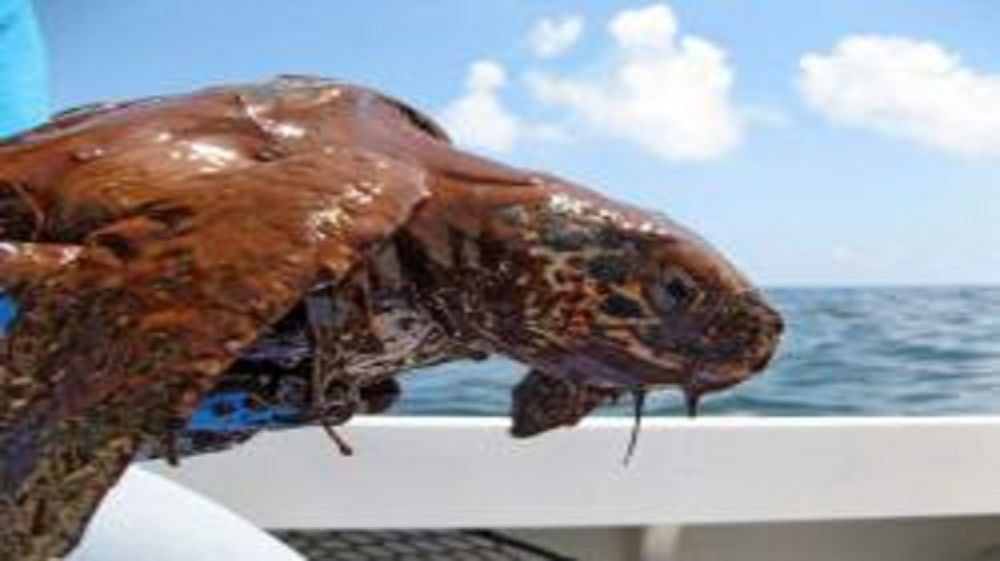Presidential commission blames BP, Halliburton, and Transocean for oil spill failures
The presidential panel investigating the causes of the massive BP oil spill in the Gulf of Mexico concluded today that drastic changes including stringent new environmental and safety requirements must be made to avert another catastrophic offshore drilling accident.
Sea turtle advocates agree that mistakes made by BP, Transocean, and Halliburton combined with flawed government oversight of the oil and gas industry triggered the worst oil spill in U.S. history – and the most devastating environmental disaster for endangered sea turtles and other marine life in the Gulf of Mexico.
“Rescue of sea turtles and establishing protected swimways through the maze of oil rigs must be prioritized in oil and gas regulations,” said Dr. Chris Pincetich, marine biologist at Sea Turtle Restoration Project, the environmental organization that forced BP to stop burning turtles during the oil spill clean-up. “Until now sea turtles have been an afterthought to oil drilling and spilling, but hundreds of deaths and the poisoning of a generation of sea turtles cannot be ignored.”
The BP oil spill led to hundreds of endangered sea turtle deaths and oiled waters and beaches where loggerheads, Kemp’s ridleys, green turtles and even leatherbacks nest. The Sea Turtle Restoration Project is advocating for the following changes to oil industry regulations for oil spill prevention and response:
Sea Turtle Protection from Oil and Gas:
• Avoidance of sea turtle breeding, foraging and migration habitat for any new or renewed oil drilling platforms. • Establishment of protected swimways through the Gulf of Mexico where new oil and gas development is prohibited and existing operations phased out.
Oil Spill Response for Sea Turtles:
• Independent observers on all oil spill response vessels to record wildlife sightings; • Sea turtle rescuers on all cleanup vessel teams; • Increase the number of qualified wildlife rescue teams on-call; • Establish a volunteer protocol for wildlife rescue assistance. • Maintaining an effective level of search effort for sea turtles and wildlife; • Endangered species prioritized for rescue and rehabilitation; • Chemical dispersants and “controlled burns” banned where endangered species are present.
Oil Spill Restoration:
• Funds set aside specifically for restoration of sea turtle nesting beaches and nearshore habitat. • Full cleanup of nesting beaches, oil free to a depth of 30 inches.
“The oil and gas industry must reform itself to show concern for the sea turtles and other wildlife of the marine environment where they drill,” said Carole Allen, STRP Gulf Office Director.
“On-water rescue of sea turtles was a bottle-neck. In the future, boat teams with fishermen and biologists should be deployed quickly to target endangered species rescue,” says Dr. Chris Pincetich.
Sea turtles in the Gulf of Mexico are threatened by the poisoning and habitat degradation brought on by the BP oil spill and continued offshore oil and gas development. Fisheries such as the Gulf of Mexico shrimp trawl fleet have undergone major modifications in gear and management in recent years to minimize deadly interactions with sea turtles, yet, the offshore oil and gas industry have not made any systematic changes to reduce their impacts to the Gulf’s sea turtles and marine life.
The offshore oil and gas industry have yet to make any systematic changes to reduce their impacts to the Gulf’s sea turtles and marine life.
Background: During the BP spill, cleanup vessels performing “controlled burns” were ignoring endangered sea turtles for over two months before animal protection groups including Sea Turtle Restoration Project organized a legal challenge to save them. As a result of a lawsuit, BP halted burning of the oil until independent, trained wildlife observer and rescue teams were placed on the “controlled burn” task force vessels.
The Sea Turtle Restoration Project also called for reduced fishing pressure to allow ecosystem recovery, continued cleanup by BP, a halt to sand dredging to build berms to block oil, an accurate calculation of the total number of sea turtles estimated as killed in the spill, impacts of submerged oil be assessed, sea turtle stranding and recovery network improvements, and complete transparency of all findings related to the toxicity of gulf seafood, contamination of the environment, and the health of sea turtles in a report released last year. Click here for the STRP BP Spill report.




